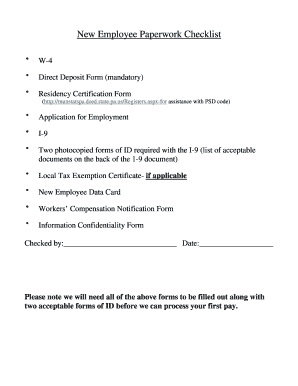New Hire Paperwork: Dress Code Guide

In the dynamic corporate landscape, one of the first impressions a new employee makes is through their attire. New hires are often met with a plethora of forms and guidelines, but none might seem as daunting as understanding the dress code. Navigating this aspect of company culture is crucial, not only for fitting in but also for showing respect and professionalism towards the organization. This comprehensive guide aims to decode the nuances of workplace dress codes, offering insights and tips to ensure that new employees start on the right foot.
Understanding the Company Culture

The workplace attire largely mirrors the company's culture. Here are some key points to consider:
- Research the Culture: Prior to your first day, delve into the company's culture through their website, social media, or employee reviews to understand their dress code expectations.
- Observe Current Employees: On your first day, observe what colleagues are wearing. Are they in suits, business casual, or does the environment lean towards more creative expression?

Different Levels of Formality

Workplace dress codes can range from highly formal to extremely casual. Here's what you might expect:
- Formal/Business Professional: This typically involves suits, ties for men, and equivalent formal wear for women. Common in sectors like law, finance, and upper management.
- Business Casual: A step down in formality, featuring slacks, blouses, skirts, or dresses, often paired with dress shoes or boots.
- Creative/Relaxed Professional: Seen in tech startups, creative industries, or design firms. Think jeans, graphic tees, and sneakers, but with a polished edge.
- Casual: While rare, some companies allow for very casual attire, like shorts, graphic t-shirts, and flip-flops.
Tips for Dressing Appropriately

- Conservatively at First: Start with more conservative choices until you have a clear understanding of the culture.
- Check for Exceptions: If there are "Casual Fridays" or specific event dress codes, make sure to adhere to these variations.
- Grooming: Ensure personal hygiene, including clean, well-groomed hair, trimmed facial hair, and appropriate use of makeup and cologne/perfume.
- Comfort: Your attire should not only look good but also feel good to boost your confidence and comfort at work.

Avoiding Common Pitfalls

Here are some mistakes to steer clear of:
- Too Casual: Even in a casual work environment, overly revealing or excessively casual attire might be inappropriate.
- Inappropriate Messages: Avoid wearing clothing with offensive language, graphics, or slogans.
- Excessive Accessories: Keep jewelry and accessories to a minimum to maintain a professional appearance.
- Poor Fit: Clothing that's too tight or too loose can send the wrong message.
The Role of Accessories

Accessories can enhance your professional appearance but should be chosen with care:
- Jewelry: A watch, simple necklace, or earrings can add a touch of professionalism. Keep it tasteful.
- Bags: Opt for professional bags or briefcases. If you're carrying a backpack, make sure it's in good condition and not overloaded.
- Shoes: Shoes should be comfortable for long days but also match the level of formality required.
- Belts: A belt should match your shoes and pants to give your outfit a cohesive look.

📌 Note: Always remember that your choice of clothing and accessories communicates a lot about you before you even speak. Dress in a way that aligns with the company's culture while showcasing your personality and professionalism.
In wrapping up this guide on navigating your new workplace dress code, it's clear that first impressions are crucial. Understanding the company culture, choosing attire that reflects the level of formality required, ensuring personal hygiene, and selecting accessories wisely are all steps towards integrating seamlessly into your new work environment. By following these guidelines, new hires can confidently present themselves as professionals who value both their own image and the company's ethos, ensuring a smooth transition into their new roles.
What if my personal style doesn’t match the company dress code?

+
While it’s important to adhere to the dress code, you can still incorporate elements of your personal style subtly. Look for pieces that align with the company’s formality but express your personality through color, pattern, or accessory choices.
How can I tell what level of formality is expected if not explicitly stated?

+
Observe your coworkers on your first day, check the company’s social media or LinkedIn profiles, or ask HR or a friendly colleague for a casual chat about dress code expectations.
Is it acceptable to wear the same outfit multiple times a week?

+
If the outfit is clean, well-maintained, and in line with the company dress code, there’s no problem with repeating it. However, variety can be appreciated to avoid monotony in your appearance.



